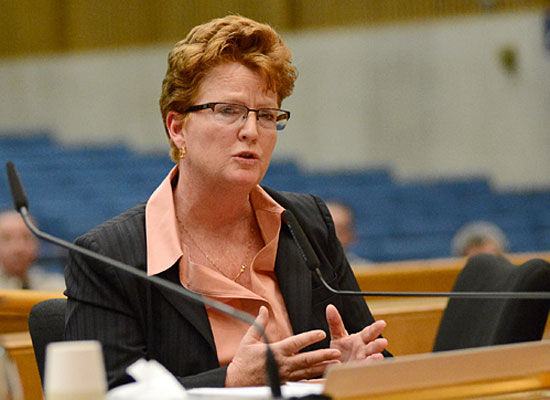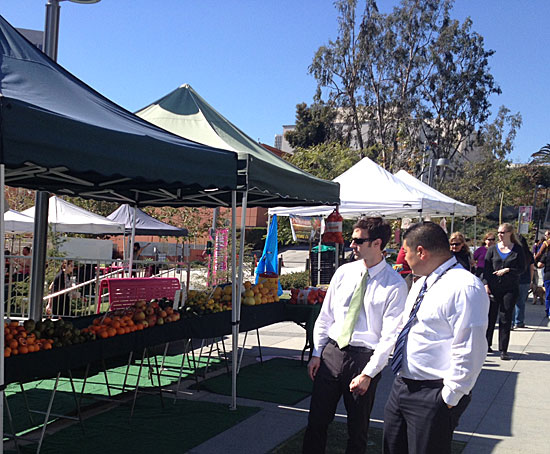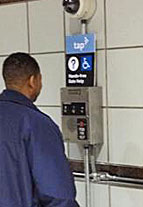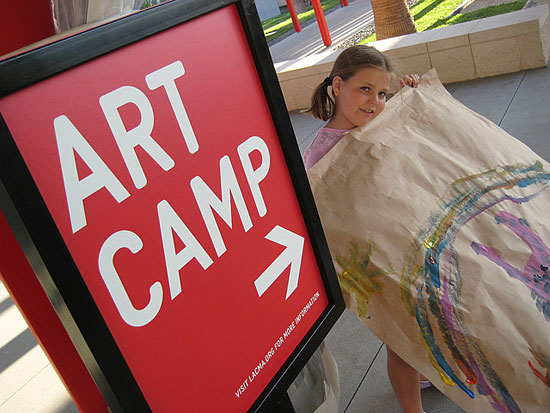Where farm meets park
February 28, 2013
Gordon Pawlowski didn’t know what to expect when he tied on his apron in anticipation of Grand Park’s first-ever farmers’ market on Tuesday. It didn’t take long to find out.
“We sold out at 12:30 p.m.,” said Pawlowski, chef and owner of Lenny G’s, a Cajun eatery. “I had to turn away a line of 30 people.”
The market will be held every Tuesday from 10 a.m. to 2 p.m. between Broadway and Spring Street, just in front of City Hall. At the inaugural event, 22 vendors were selling berries, flowers, crafts, exotic spices and teas, baked goods and prepared foods like Pawlowski’s popular po’ boys. Julia Diamond, Grand Park’s programming director, said organizers started small on purpose.
“At its core, a farmers market is about supporting independent business owners, small farms and local vendors,” said Diamond. “My biggest concern is for them, because they take the risk in coming there.”
The event drew an estimated 1,500 people—a mix of workers from adjacent buildings, passers-by and local residents.
“It went gangbusters,” said Diamond.
Fresh produce lured Carolyn Lifsey and Monica Roache away from their work at MOCA, about six blocks away on Grand Avenue. They learned about the event from Grand Park’s Facebook page. (Grand Park also is on Twitter.)
“The walk is actually kind of nice,” Roache said. “Being that it’s in the park, it offers a really tranquil ambiance for lunchtime.”
Others, like downtown worker Henry Chisom, said they were hoping for a bigger selection and smaller prices. He also hopes to see some music added to the mix.
He may be in luck.
Given the success of the trial run, Diamond plans to expand the market to meet the demand. (“We will have more farmers next time,” she said, referring to the fact that only a handful of produce vendors were selling on Tuesday.) Also, on alternating Tuesdays through the end of May, Lunchtime Concerts in the Park will add live music and food trucks on the block between Grand Avenue and Hill Street, effectively activating the whole park.
Other than the farmers’ market, relatively few organized events have taken place in Block 4—a grassy, expansive section of park. Diamond was jazzed to see the area bustling with activity.
“It’s such a big space,” she said, “that it takes the right kind of event.”
Posted 2/28/13
Dave+Apollo=animal attraction
February 28, 2013
This really is a bird of another feather.
For starters, she’s got a masculine name—Apollo. But that’s nothing compared to this: She’s got a serious turkey vulture crush on a bearded, soft-spoken Los Angeles County worker named Dave Stives.
Stives, the county’s regional animal keeper, has become accustomed to Apollo working herself into a hormonal tizzy when he nears her enclosure at the Placerita Canyon Nature Center in the Antelope Valley, especially during spring mating season. Among other things, she spins in circles and flaunts her tale. “A courtship dance,” says Stives.
Apollo and Stives first met nearly a decade ago. Apollo had been hit by a vehicle in Virginia and was shipped west for treatment at a private facility in the Antelope Valley. A tendon in Apollo’s wing had been damaged, thus bringing her flying days to an end. In those early days, Stives had helped in her care and training. Two years later, when the private facility went under, Apollo was moved to the county’s Placerita Canyon center. It was love at second sight.
“She remembered me and trusted me,” Stives says. That was seven years ago, he says, and the relationship is still going strong. “She follows me around like a puppy dog,” Stives says affectionately of the black-feathered, red-headed vulture.
Stives, 48, has worked as an animal keeper for the county’s Department of Parks and Recreation for some 14 years. He’s responsible for the seven nature centers and parks that house a menagerie of animals, including birds, possums, raccoons, rattlesnakes—“probably anything that is indigenous in the state,” he says. He travels from one facility to the next making sure all are in compliance with state and federal laws governing everything from the diet of the animals to their educational use, a requirement for the county to keep them. “We make sure they have the best possible life under our care,” Stives says.
At home, Stives also has some feathered and furry friends—two dogs, two cats, three falcons, plus a snake. As a “master falconer,” he takes his birds into the wild, where he’s “conditioned” them to circle overhead as he beats the bushes for rabbits. The falcons then swoop in.
As for Apollo, she now spends her weekends with Stives at educational animal shows, dispelling myths of vultures as the creepy outcasts of the bird world. “She’s actually quite pretty,” he says. “In her own way.”
To see the two in their native habitat, click on the video above.
Posted 2/28/13
Operatic opportunity, open to all
February 28, 2013
This one’s going out to all you shower-singing sopranos, tenors and basses out there. If you’ve ever wanted to belt out the toreador song from Carmen in public, your moment has arrived.
And you can do so under professional supervision, as LA Opera presents its first annual “Great Opera Choruses” program on Saturday, March 2.
The event is free, but reservations are required to take part in the opera’s presentation of “Sing Out Loud!” at 1 p.m. at the Campus Theatre at Cal State Northridge. Billed as a “participatory recital,” the audience will get to sing along with opera professionals on works including “Toréador” from Carmen, “Libiamo” from La Traviata, and even “Oh, What a beautiful Morning” from Oklahoma! (There will be handouts, so no worries if you haven’t committed all those lyrics to memory.)
Call (213) 972-3157 to reserve free tickets, or email [email protected].
Earlier in the day, an 11 a.m. performance of a specially-commissioned short version of Mozart’s The Magic Flute—featuring San Fernando Valley schoolchildren along with opera artists and audience participation sing-alongs—is sold out, but there will be a standby line.
The theatre is located at 18111 Nordhoff St., Northridge, 91330. Parking in Lot B1 on Nordhoff is $6.
Posted 2/28/13
It’s a lock: subway tests underway
February 27, 2013
As Metro officials prepare to latch the gates on L.A.’s subway system this June, they’ve had obstacles to overcome in familiarizing passengers with the TAP cards that are now mandatory for most travelers.
The final frontier, though, has been figuring out a way to allow Metrolink riders, who use paper tickets, to connect seamlessly with Metro trains once the gates are locked.
The solution: microchip-embedded paper tickets that will unlock gates for Metrolink commuters passing through.
Starting in March, that workaround will be getting a major tryout in the real world, with gates temporarily locking at Union Station’s West Portal during certain planned intervals as part of a joint project by Metro and Metrolink.
The object is to see if Metrolink riders and an in-house test group of passengers can navigate the gates smoothly.
Meanwhile, an intermittent series of locking tests has been rolling out elsewhere in the system to see how the TAP card-carrying public is faring—and how Metro employees are responding.
Recent tests at the Wilshire/Normandie, Wilshire/Western and North Hollywood stations have put staffers through their paces responding to patrons’ calls for assistance through the “Gate Help Phone System,” or GTEL, which is being installed at all stations with gates.
“This whole effort right now is to get our folks who man the GTELs some practice,” said David Sutton, Metro’s Deputy Executive Officer of TAP . “I don’t think they’ve had any questions they can’t answer.”
Sutton’s team also is grappling with occasional glitches like the bottlenecks that can crop up when a passenger’s TAP card doesn’t work, or a customer attempts to maneuver a bicycle through an emergency door.
“Customers are on a learning curve, that’s true, but they seem to be getting it,” Sutton said. “Even at North Hollywood, which is a very, very busy station, they’re getting it.”
Posted 2/27/13
Want a happy camper? Be first in line
February 27, 2013
There’s a secret to getting your kid into a great summer camp: Sign up before spring.
Unfortunately, most parents remember that secret just as the school year is ending. But for those who do register early, Los Angeles County is a summer playground of options.
Here’s a sampling of what’s out there. Act quickly. Some already are selling out.
- Enrollment opened last week for the Los Angeles County Museum of Art summer art camp, and some weeks are already fully booked. Several are still open, though, with artist-led workshops for art-loving kids aged 6-13. The camp runs from 10 a.m. to 3 p.m. starting June 10, and proof of age is required. Tuition is $365 per week ($325 for NexGen members). Financial aid for art camp is also available. For more information, call 323-857-6512 or click here.
- Sign-ups also opened this month at the popular Summer Nature Camp at the Los Angeles County Arboretum & Botanic Gardens, which offers weeklong sessions of outdoor and indoor fun for children aged 5-10. The program runs from 9 a.m. to 3:30 p.m. with extended care from 8-9 a.m. and 3:30-5 p.m. if parents need it. Sessions start June 10 and run through the week of August 5. Tuition excluding extended care is $300 a week for Arboretum members and $335 for non-members. Half-day sessions also are available, and there’s a 10% sibling discount. For more information, call 626-821-4623 or click here.
- Another big crowd pleaser is the Adventures in Nature Day Camp at the Natural History Museum of Los Angeles County, which offers sessions in everything from fossil labs to filmmaking for kids in kindergarten through 8th grade. Registration opens March 1 for the weeklong sessions, which start June 24 and run through the week of August 5. Program hours are 9 a.m. to 3 p.m., with extended care from 8-9 a.m. and 3-5 p.m. if needed. Tuition excluding extended care is $250 a week for members and $300 a week for non-members. A limited number of scholarships are available. To sign up early, watch this space. For more information, call 213-763-3348 or click here.
- The Mountains Restoration Trust’s Discovery Nature Camp for little naturalists has some good news and some bad news. The bad news is that it will only be available for one week—the week of June 24—this summer, and there are only 18 available spaces. The good news is that if you’re reading this, you could be first in line. The camp, which operates out of a historic farmhouse in the Santa Monica Mountains, offers hands-on interaction with nature for children aged 8-12. Hours are from 9 a.m. to 3 p.m. and tuition for the week is $260. For more information, call project manager Susan Haugland at 818-591-1701 or click here.
- Nothing says summer in SoCal like Junior Lifeguards, but good programs can require some advance swimming prep. Registration for returning junior guards in the Los Angeles County Fire Department’s program starts March 4. This year’s program runs Monday through Friday from July 1 to August 2, with morning or afternoon sessions in crucial ocean skills for kids aged 9-17. Fee is $476 and financial aid is available. New registrants must show proof of age and pass a swim test. Experienced Junior Guards 16 and over can qualify for the department’s Cadet Program. For much more information, or to find the camp nearest you, call 310-939-7214 or click here.
- The surf and beach camps traditionally operated by the Los Angeles County Department of Beaches & Harbors are still on hiatus, due to budget cuts. But plenty of community beach programs have arisen to fill the gap in the meantime. For a list of community-based summer youth camps operated at local beaches, click here.
- Just keeping an eye out for kid-friendly outings? Check out SummerSounds at the Hollywood Bowl. A music festival designed just for little ones, SummerSounds features two concerts daily through July and August, at 10 a.m. and 11:15 a.m., plus arts and craft workshops, for kids 3-11. The music ranges from gospel to mariachi to reggae to traditional Filipino music—and it’s a bargain. Tickets aren’t on sale yet, but traditionally they have been $7 regardless of age and $5 for workshops. For more information as summer approaches, watch this space.
Posted 2/27/13
Major closure, but no Carmageddon III
February 27, 2013
Motorists, be forewarned: the northbound 405 Freeway will be a great place to avoid the first weekend in March.
Three northbound lanes on the freeway will be closing for 55 straight hours between Montana Avenue and Getty Center Drive. In addition, the Getty Center Drive and Moraga Drive northbound on-ramps will be closed, as will the northbound Montana and Moraga off-ramps.
Despite the length of the closure, this is no “mini Carmageddon”—although officials stress that drivers should plan alternate routes through the area to avoid major backups.
“We are concerned with daytime traffic,” said Kasey Shuda, construction relations manager for the project. “Obviously, there will be some delays if people don’t divert.”
Still, she added: “It’s not that big of a deal at all. It’s not like Carmageddon at all…We do three-lane closures at night all the time.”
Northbound travelers should get off at Wilshire and take Sepulveda Boulevard as an alternate route through the area.
The closure is needed so that workers can pave a portion of the new carpool lane that’s at the heart of the massive construction undertaking; bridges and ramps also are being widened and rebuilt as part of the overall improvement project.
All in all, it could be worse: there’s no need for a similar three-lane closure on the southbound side because workers were able to complete that work during Carmageddon II.
Weather permitting, the closures will begin at 10 p.m. on Friday, March 1. The lanes are expected to reopen at 5 a.m. on Monday, March 4.
Changeable message signs publicizing the coming lane closures are already up in the area, and beginning March 1, Caltrans signs countywide will alert motorists about travel times in the closure zone throughout the weekend. Traffic control officers will be on duty and there are contingency plans to close more ramps if needed to keep traffic moving along Sepulveda.
Learn more about it at an upcoming community meeting scheduled for February 28.
Posted 2/13/13
Attention thrift store shoppers
February 27, 2013
You don’t need to be a hip-hop enthusiast to go out and “pop some tags” at the thrift shop. And thanks to the L.A. County Board of Supervisors, that vintage velour jumpsuit and those used house slippers may be closer than you think.
The supervisors on Tuesday eased zoning restrictions on secondhand stores in unincorporated Los Angeles County, making it easier for nonprofits such as Goodwill Industries and the Salvation Army to set up shop in neighborhood business districts.
The county code revision, which expands the commercial areas in which vintage stores can do business, was proposed last year by Supervisor Don Knabe after a request from Goodwill, but represented a long-overdue updating of the zoning code, says Bruce Durbin, supervising regional planner in the Department of Regional Planning’s ordinance studies section.
“Essentially, secondhand stores had been in the same zoning category as recycling yards and pawnshops,” says Durbin, noting that such stores weren’t even classified in the zoning code until the Great Depression. “The idea was that they had the same impact as, say, a place that sold scrap metal.”
But secondhand stores since then have become more like other retail outlets, he says. Indeed, the No. 1 song in the country right now is Macklemore & Ryan Lewis’ bawdy anthem, “Thrift Shop,” in which the singers vow to shop ‘til they drop—or “pop some tags”—even though they only have $20 in their pockets.
“These days, thrift shops operate like, say, a Marshall’s—they receive bulk materials, sort it, price it and put it in a showroom. So this was a matter of the zoning catching up with the use.”
The amendment allows secondhand retail stores to open in so-called C-2 zones, as long as the lot isn’t residential and all the drop-off, storage and sorting is done indoors during business hours.
At least one city expressed concern that the change might cheapen municipal shopping districts that border on unincorporated county areas. San Marino noted in a letter that thrift shops could theoretically set up shop across San Gabriel Boulevard from the upscale community, which only allows the sale of new goods.
Nonprofits, however, supported the measure, with letters and testimony from the Salvation Army, the St. Vincent de Paul Society and the AIDS Healthcare Foundation, which operates the popular Out of the Closet thrift shops.
“This ordinance is going to be great,” says Michael Pauls, a Long Beach-based land use consultant to Goodwill who predicts that it will enable the nonprofit to add as many as a half-dozen new outlets over the next two years to the 40 or so stores it now operates countywide.
Since the recession, he says, Goodwill has been trying to expand its offerings of household goods and used clothing; it also has sought to respond to a massive influx of used book donations by opening a new tier of Goodwill bookstores. But when zoning prevented the nonprofit from moving on a series of retail vacancies in unincorporated commercial areas near Santa Fe Springs, Pasadena and Hacienda Heights, Goodwill sought relief from the county.
“In the last 20 years, thrift stores have become very popular with the shopping public,” Pauls says, noting that secondhand stores not only offer low-cost shopping, but also divert used goods from landfills and, in many cases, provide jobs and job-training programs.
“We’re no longer the rummage sales or ‘Sanford and Son’ image that people often equate with us.”
Posted 2/27/13
She’s the new jailer in town
February 22, 2013

Terri McDonald, formerly a top California correction's official, will oversee L.A. County's troubled lock-up.
Terri McDonald is taking a break in one of her favorite places, the warden’s office at Folsom State Prison. She’s sentimental about the whole place, with its thick granite walls and colorful history as one of America’s oldest operating prisons. Years back, she worked there as a captain. More recently, she’s been overseeing it—along with 32 other California lockdowns—as operations chief for the state’s penal system, the largest in the nation.
On this day, during an interview with a caller from Los Angeles, she sounds more like a social scientist than a prison boss. “They are their own communities,” she says of the state institutions, “each with its own ebb and flow, each with its own subculture.”
Behind the walls, she says, you’ll find “the most complicated people in California,” men and women “too problematic to be in society,” thrown together with an undercurrent of “gang allegiances and sociopathic influences.” Some inmates might be only 18 years old, she says, others 90. Some may have developmental disabilities, others Ph.D.’s.
“It’s just fascinating,” McDonald says enthusiastically. “I can’t wait to see how L.A. works.”
Come March, she’ll get that opportunity when she assumes her newest—and, arguably, her highest profile—position during a quarter-century career in corrections; McDonald has been selected as assistant sheriff for the custody division of the Los Angeles County Sheriff’s Department—a post created as one of the top priorities of the Citizens’ Commission on Jail Violence. McDonald, 49, also will hold the distinction of being the highest-ranking woman in the department’s history.
“It’ll be a challenge,” she says of the new job, “but certainly not overwhelming.”
McDonald’s selection by Sheriff Lee Baca represents a significant departure for the department, which historically has promoted from within. The blue-ribbon jail panel stressed the importance of naming an outsider to the new custody position, someone with a record of success in managing a large corrections facility or department. In its final report in September, the panel noted that the previous three assistant sheriffs responsible for custody operations had come from the department’s patrol side “and none had any recent experience in the jails.”
The panel, whose members were appointed by the Board of Supervisors, also recommended that the new position report directly to Baca to enhance accountability and “remove the filtering process that accounts, in part, for the Sheriff not knowing of ‘bad news,’ while at the same time reducing [Undersheriff Paul Tanaka’s] influence over Custody operations.” The jail commission blamed Tanaka for undermining efforts aimed at reducing brutality among some deputies assigned to the county jail system, which is managed by the Sheriff’s Department.
In the wake of the findings, Baca acknowledged management failures of his own and agreed to implement the panel’s 60 recommendations, including conducting a nationwide search for the job McDonald cinched.
“My expectation for her is to tell me the good, the bad and the ugly and to proactively head off problems, solving them before they get out of control,” Baca says. “This was a gap that needed to be closed.”
Baca emphasized, as did the commission, that he has made substantial progress already in reducing the use of unnecessary force in the jail and expects McDonald to build on those reforms and others, including the expansion of inmate educational programs.
The commission’s general counsel, Richard Drooyan, says McDonald “certainly has the experience and background” to tackle the problems uncovered during the panel’s nearly year-long investigation. “I think it helped bringing in someone from the outside to restore credibility to the process,” says Drooyan, who is now monitoring the department’s implementation of the commission’s reforms.
McDonald, who grew up in the small Stanislaus County town of Oakdale, went to work for the California Department of Corrections and Rehabilitation at the age of 25, specializing in inmate mental health issues. Since 2011, she’s been functioning as undersecretary of operations, overseeing adult institutions, parole operations, juvenile justice and rehabilitative programs. Among other things, she says that, because of massive overcrowding, she was responsible for moving 10,000 inmates to five other states, giving her a national perspective on prison models.
During the past year, her state job also has brought her into direct contact—and sometimes conflict—with Los Angeles County. She’s been the California prison system’s point person for “realignment,” the highly controversial shift of certain oversight and incarceration responsibilities from the state to its counties. It’s been her job to coordinate this unprecedented remaking of the state criminal justice system with local probation officials, sheriff’s departments and mental health experts.
Now, she’ll be on the hook for managing the fallout in L.A. County’s jails, where thousands of inmates are being sentenced for crimes that used to land them in state custody—and for terms longer than those previously imposed on county jail defendants. “In my new role,” she says, “I’ll have the opportunity to see the impact and work on solutions.”
As for the scandal of excessive force in the county’s jail that led to her landing the $223,087-a-year job, McDonald says she’s up for the task. She notes, among other things, that she was a “master trainer” for the state’s use of force policy and was instrumental in revamping the training academy’s ethics curriculum.
“I understand the realities of working in correctional environments and how to make fundamental changes,” she says. “I’ve been in situations where I’ve been battered and been in riots. I’ve used force. I think folks have to realize that force is a reality of jails and prisons.” But, she says: “The force used must be the minimum amount to resolve the problem and not used as punishment.”
Posted 2/22/13
Here’s a car-free route to the beach
February 22, 2013
However you roll, you won’t want to miss the next CicLAvia, which blazes a new trail through the Westside before culminating at Venice Beach.
The map for the April CicLAvia was released this week, showcasing the event’s longest route so far, stretching about 15 ¼ miles between City Hall and Venice Beach. It follows Venice Boulevard most of the way, although there are shorter stretches on Figueroa, Main and 2nd streets downtown.
Since 2010, the popular bike and pedestrian events have reached out to new communities while opening up some of L.A.’s streets for healthy car-free fun. This is CicLAvia’s deepest foray yet into the Westside.
The moveable street party runs from 10 a.m. to 3 p.m. on Sunday, April 21.
CicLAvia “hubs”—providing meet-up places and pit stops for refreshments, relaxation, and bike repairs—will be located at El Pueblo, City Hall, Normandie Avenue and along Venice Boulevard in the Fairfax District, Culver City, the Mar Vista Farmers’ Market, near Abbot Kinney and at the beach .
Posted 2/22/13



















 Check for the latest closure information
Check for the latest closure information








